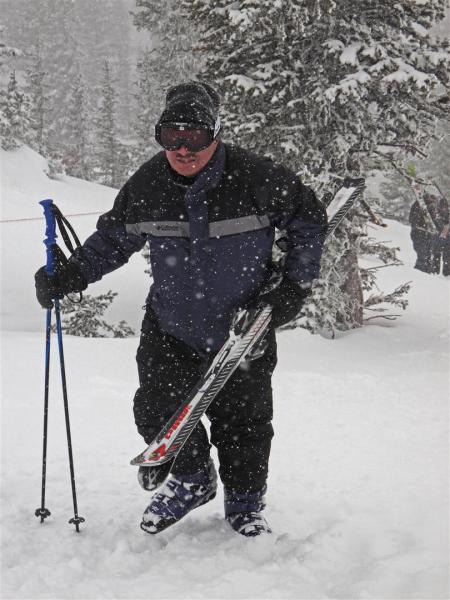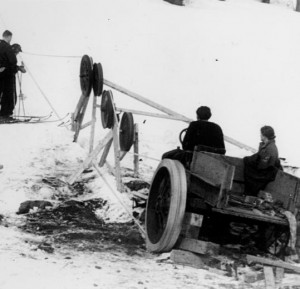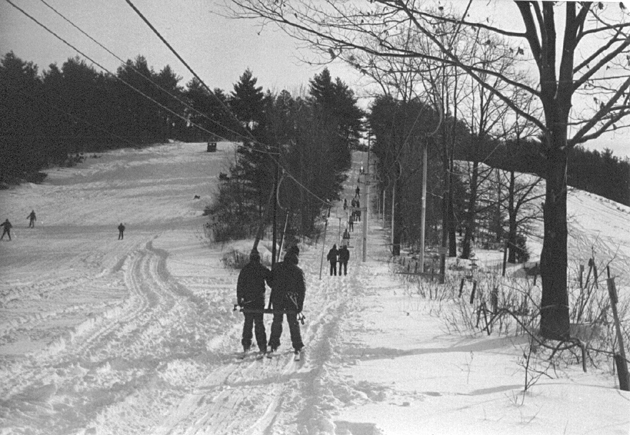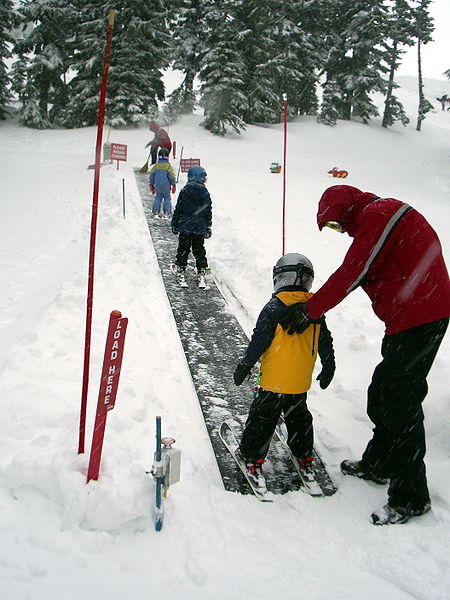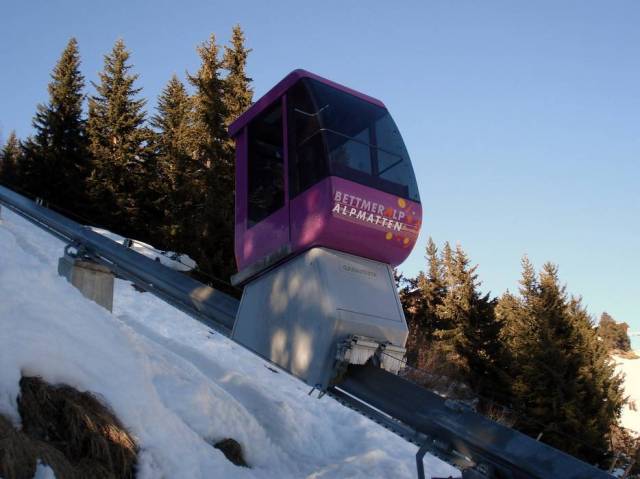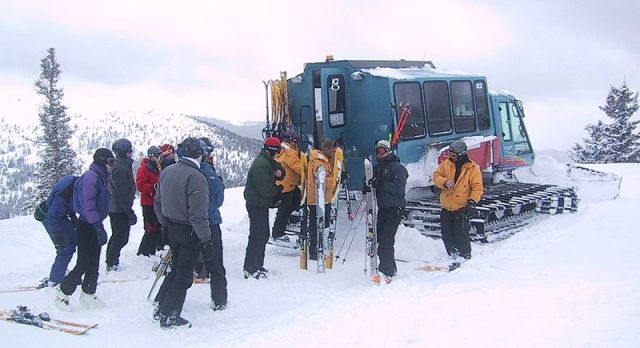Last season I wrote articles on two major technological developments that made skiing and snowboarding what it is today. These were the inventions of the snowcat and snowmaking. However, these amount to nothing if it wasn’t for the most important invention of the all. Of course I am referring to the development of ski lifts. To adequately cover the topic of ski lifts I had to divide it up into three articles. The first of these articles covers surface lifts. These lifts transport skiers and boarders up the hill without ever leaving the ground. This article covers the various types of surface lifts and why we love to hate them. The second article covers the cure for the surface lift, the chairlift. Part 3 presents the grandest and most prestigious lift of them all, the aerial tram.
Hiking uphill – Hiking up the hill is most primitive but still the cheapest form of surface lift around. It doesn’t cost a cent to you or to the ski area. Every hill and mountain becomes a potential ski run. To get to the top of the hill you simply hike up it. You do it either carrying or preferably wearing your skis. This is how I started skiing. I took an old pair of skis I found in the outhouse behind our house (that’s no lie ski bums), cleaned the rust off the bear trap bindings, clapped them to my feet and hiked up the hill behind our house. Soon I was joined by my buddy bobby from down the road, who thought what I was doing was cool. He soon found a pair of skis too. Since we had no lift Bobby and I got up the old fashion way.
Anyone who has done this quickly discovers significant problems with hiking uphill. It’s a tedious, time-consuming, and exhausting process. Needless to say my friend Bobby and I were only good for a handful of runs before heading back inside where my mother would make us some hot chocolate. Up until the end of the nineteenth century this is how skiers got up the hill.
You would think the development of ski lift technology would have made this form of surface lift obsolete. That’s not the case. In the last several years, this form of surface lift has made a comeback. The development of back country skiing and ski mountaineering has made it cool to hike uphill again. While it gives you access to less traversed terrain and earns you macho kudos among your ski bum buddies, it’s still tedious, time-consuming, and exhausting.
It’s also no longer cheap. To hike up the hill with your skis on you need $200 climbing skins so you can grip the snow. Most important of all is to get a pair of convertible bindings that allow a free heel going uphill, and then can be fixed to the ski when going downhill. Of course, these hybrid bindings don’t come cheap. Expect to pay upwards to $500 per pair. Let’s not forget all the other climbing gear you’ll need if you want to do some true ski mountaineering down the Eiger or Everest.
I ask you ski bums, do you feel like spending beau coup bucks for the privilege of exhausting yourself hiking/climbing uphill for one, albeit grand downhill run? Maybe I’m just getting too old. Nahh. I wouldn’t have done that even in my 20-something years. Let’s face facts ski bums, if hiking up the hill was so much fun they would have never invented mechanical means to get up the hill.
Follow the link to see what ski mountaineering is all about:
http://www.youtube.com/watch?v=NtPtQGPTpYw
Rope tows – By the 1920’s and 1930’s small ski areas began popping up and wanted to spare their patrons the uphill hike. No one seems to know who came up with the idea but signs advertising “ski tows” began popping up along the roads in New England. These “ski tows” were typically rope tows assembled from old auto parts. Somebody had to be discredited for inventing this instrument of ski torture and Jean Pomagalski generally gets the blame. He developed a rope tow in 1934 for Gilbert’s Hill in Woodstock, Vermont.
It’s debatable if the rope tow was really an improvement over just hiking up the hill. Anyone who has used a rope tow knows what I’m talking about. The rope was constantly moving and one had to grab a hold of it. It took a second or two to grab hold, during which time the moving rope ate up your gloves. An expensive pair of gloves could be quickly shredded to nothing. Moreover, the moving rope burned any other surface it came in contact with like coats and skin. Not only was the moving rope bad for gloves and parkas, over time the rope’s roughness would smooth out and become impossible to grip. Finally, if no one was using the rope the user had to lift it off the ground. 600 feet of rope can be quite heavy if you had to pick it up yourself.
There were other problems as well. There was the track you had to follow as you got pulled up the hill. The track was often more of a hazard than the rope. Then there was what would happen if you wore loose clothing. I leave it up to your imagination to figure out what happened next.
The addition of handles on the rope was some improvement. Now you could grab a handle and save your gloves. Nevertheless, it’s not much of an improvement. Every ski instructor at Brandywine dreads the moment he or she has to take the “never-ever” beginner class up the rope tow for the first time. Believe me, you want to get those kids onto the chairlift as soon as possible.
Rope tows in one form or another are still around. Because of their limitations they can only be used on gentle slopes for only about 100 yards. I think we all try to avoid them.
Follow the link to see one of the many problems with rope tows. The question is, how did the guy ever do that:
http://www.youtube.com/watch?v=6-6pQwo_9r4
T-Bars, J-Bars, & Platters – Rope tows evolved into other surface lifts like the T-bar, J-bar, and platter lifts. A swiss inventor named Ernest Constam brought us first the J and then T-bar in about 1935. This lift towed skiers uphill by a wooden inverted T caught behind the legs. The stem of the T attached to a length of cable that reeled in and out of a mechanism attached to the main cable or haul-rope. Skiers leaned back on a bar or inserted a circular platter between their legs. The skier would then be pulled up the hill. This lift became the primary method for hauling skiers uphill for about 30 years. In the 1960’s they were the dominant form of uphill transportation because, quite simply, they’re cheaper than chairlifts. You can still come across them here and there. To their credit these surface lifts were a dramatic improvement over rope tows. The good news was your gloves loved these lifts and they could take you further up the hill.
The downside – they were still a literal pain in the rear. You still had to negotiate an irregular and difficult track, and you’d be exhausted by the time you got to the top of the hill. Then there was the problem of what to do if you fell halfway up the hill. Where do you go? Many times there was no easy access to a trail and it was nearly impossible to get back on the lift.
If that wasn’t bad enough then there was the problem of what the guy coming up behind you would do seeing you sprawled all over the track. It’s a terrible experience to see your death slowly and inevitably approaching. There was still the problem with loose clothing. One time my buddy Bobby hooked his parka onto the bar as we were getting off the lift. Next thing I hear my name called in a pathetic plea for help. I looked around to see my buddy being hoisted up in the air by the T-bar. By the time he got to the bull wheel he was about 6 feet off the ground. What does a guy do when he sees his friend in such a predicament? – begin laughing hysterically. Fortunately, the operator stopped the lift and cautiously helped my buddy down, watchful he didn’t collapse on top of him when he succeeded in jarring him loose.
Follow the link below to see one of the problems with T-bars:
http://www.youtube.com/watch?v=POzEvqL-YTw
Sled lifts – Then there was the Aspen boat tow. In the winter of 1936-1937 the Roaring Fork Winter Sports Club (later to become the Aspen Ski Club) wanted to have a lift to take skiers to the top of the hill so they could go down the runs they cut out the summer before. They came up with the “boat tow,” which literally was a boat skiers got in and then were tugged to the top of the hill by a rope. It was made of an old car motor, two mine hoists, and two ten-person sleds.
The boat or sled tow is now a quaint memory of a time when ski lift technology was make-shift and improvised. So what was wrong with it? First and probably foremost was the uphill capacity. The Aspen boat tow could only transport 10 passengers at a time. There was only one boat per lift. This might have been fine if there weren’t many skiers around but it’s not a practical form of uphill transport when there are thousands of skiers on the slopes. Needless to say, the boat tow was quickly replaced by Chair #1 at Aspen, which not only carried more skiers per hour but also went a whole lot further.
While you don’t have to worry about falling out of the boat (I think), you still had the problem of transporting skiers on an irregular surface. You need a track for the boat or sled to follow up the hill. That track has to be cleared of snow, which could be a major headache after a 3-foot dump.
While we don’t see sled lifts today the technology morphed into something else. The sled tow was found to be more fun going down the hill than up it. Thus the alpine slide and the mountain coaster were created. Somebody had the bright idea in the 1970’s of constructing a concaved concrete track that snaked down a ski run. You go down the track in a Luge-type of sled. Ski areas thus found a way of generating summer-time revenue. I can personally testify they’re great fun. There are two basic problems with the alpine slides though. First, you can only use them during the off-ski season. Second, they can be hazardous to your health if you go too fast. Also the sled didn’t take you up the hill. You rode a chairlift to the top and then sledded down. The mountain coaster corrects the problems of the alpine slide because it is attached to a track and cannot fly off if you go too fast. It can also be used year-round, even in the snow. Just like Aspen’s old sled lift, riders ride up the hill in the sled, but then ride down it as well. To avoid the problem of having to clear the track of snow, the track is elevated off the ground.
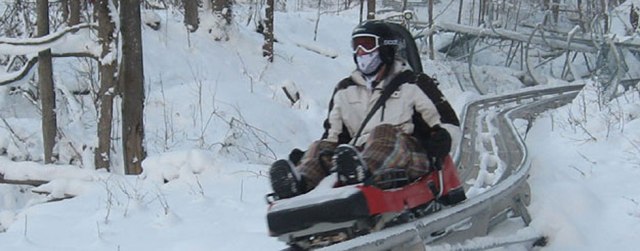
The Holiday Valley Mountain Coaster. Looks like fun but I think I prefer the other way down the hill.
Follow the link below to see the old Aspen boat tow in action:
http://www.youtube.com/watch?v=qhistnLhPdE
Magic carpet lifts – These are basically ground-level conveyor belts. Skiers slide onto a conveyor belt at the base, which then pulls them to the top. At the top the belt pushes skiers onto the snow as they slide away. They are the least threatening form of ski lift for children and beginners. You can’t fall from a great heights and are far easier to use than T-bars. On the other hand they are limited to shallow grades because they depend on the friction between the carpet and the bottom of the skis. They are slow and only good for short distances. Yeah they’re safe but also really really boring. Finally, they constantly have to be cleared of snow. Because of these limitations you only see these lifts around beginner areas. The exception to this is the Snowbird Tunnel in Utah. There you take a magic carpet from the front of the mountain, through the mountain, and to Mineral Basin on the back side.
Follow this link and take a trip through the Snowbird tunnel magic carpet.
http://www.youtube.com/watch?v=_uNUY30PK3I
Funiculars – Cable railways or funiculars have been around as long as there have been mountains and tourists want to get to the top of them without having to climb up them. These first began to be seen in the Swiss alps in the 1870’s. Funiculars are typically not used to transport skiers to the top of the mountain though. Some European ski resorts have them as actual ski lifts but there really isn’t any in North America. The Funicular at the St. Regis Hotel at Deer Valley is the closest example to a funicular lift in North America. However, this lift only transports hotel guests up the hill to the hotel and is not used to transport skiers. Even in the European countries, funiculars are primarily used to link ski areas together over mountainous terrain. They transport skiers from one base area to another. Some European resorts transport you up the mountain through a variety of funicular-chairlift combinations. The funicular takes you up part of the way, where you can then access various other lifts.
I’m curious to know why we don’t see more funiculars. They are fast, can haul a lot of skiers, they’re comfortable, go long distances, and go up fairly steep inclines. I suspect it’s a matter of cost and maintenance. Basically, you are building a railroad line on a ski slope. That’s expensive. When compared with a high speed quad, the cost of building a funicular is un-economical. Second, funiculars have the same problem as other surface lifts. Snow covers the tracks and have to be cleared off. You don’t have to do that with a chairlift. Finally, in researching this topic it became a apparent another problem with the ski-area-to-ski-area funiculars in Europe is the standing around and waiting for the train. We’re losing slope time ski bums waiting for the next train. Personally, I’d rather be skiing than waiting for a train.
Follow the link to take a ride on the Parsenn funicular railway at Davos Switzerland.
http://www.youtube.com/watch?v=6Tymmk6zG9k
Snowcats – When heli-skiing and backcountry skiing began taking off, ski areas out west found a new way of putting their groomers to work. Why not haul skiers up the hill to some isolated acreage not served by a lift and charge them for it? What a re-invention of a great idea. I mean for those of us who don’t feel like hiking up the hill and can’t afford heli-skiing, this is the ideal solution.
Transporting people to the top of the hill has been around as long as snowcats have been used on ski slopes. One of the first uses of snowcats was to take non-skiers up the hill to catch the view at the top and to watch all those crazy skiers killing themselves on the slopes. However, it wasn’t until the early 1980’s when we began seeing companies in Canada using snowcats expressly for the purpose of transporting skiers into the backcountry. Since then, most large ski areas out west offer some snowcat skiing option. Even though I say it’s a “poor” man’s ticket to the backcountry, it still isn’t cheap. Expect to pay $400 to $500 per day for 7 to 12 runs. But what runs they are. However, some western ski areas will offer free (Copper Mountain) or $5-per-ride (Keystone) snowcat transportation to their expert terrain. Just you wait, in the next few years you’re going to see more and more snowcat skiing. Eastern ski areas are discovering they have some backcountry too. They don’t need helicopters and snowcats are the ideal form of access for them.
Follow the link to learn more about snowcat skiing:
http://www.youtube.com/watch?v=UdYt0JB7y3A
To their credit, surface lifts brought skiing to the masses. While largely a pain in the rear, they will always be around. They are relatively cheap and good for transporting skiers up beginner and intermediate terrain over short to moderate distances. They are also our ticket to the backcountry. Yes, they’ll be around for the foreseeable future.

